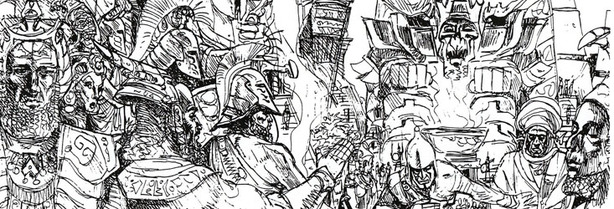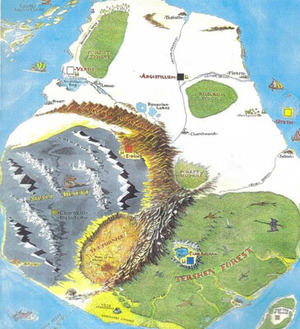
Beyond the Page
As Dave rightly noted, by the time Fabled Lands had finally hit its stride the gamebook craze was coming to an end, with computer games becoming a more popular avenue for escapism. As 1996 drew to a close both Jamie and Dave decided to use their experience with gamebooks to launch themselves into the computer games industry – taking the Fabled Lands series with them.“We’re old-time gamers,” says Dave when it comes to his familiarity with computer games. “We got heavily into computer games right from the start with titles like Wizardry, Dungeon Master and Might & Magic.”
In many ways then it shouldn’t be all that surprising that the pair would try to adapt the unfinished Fabled Lands series to a computer game – after all, many of their original ideas and inspirations had been drawn from that same area and the idea of a sandbox RPG makes a lot more sense there than it does in a book.
What is a bit more astounding though is that Eidos would take the two on and put them to work on creating an MMO based on the series. Nowadays, with World of Warcraft having proved how viable that market can be, fantasy MMOs are a dime a dozen – but in 1996 it was a different story altogether.
“Everquest and Asheron’s Call had been released, or were about to be,” Jamie recalls. “Eidos set us up as a kind of MMO kernel, researching some tech and working out what it would cost to do.”
Trying to base the game on the Fabled Lands series was an obvious and easy step, especially since the franchise already had a fanbase and much of the fiction and underlying systems had been developed. Instead, the hard part came from getting Eidos – then a UK-based publishing giant thanks to the success of Tomb Raider– to greenlight the project.
“I don’t think anybody at Eidos had even heard of MMOs!” Dave says. “We realized that the competition among major MMOs would not be just for the players’ monthly dollars but for their time too. Once you’re level 20 in WoW, you have to have a good reason to switch games. So, our reasoning was that [we] should get in early with a game of sufficient ambition to scare off the competition.”
“But it was a leap in the dark for Eidos. One of the publishing guys, I think it was Jon Kavanagh, said to me, ‘We just don’t know if MMOs will make any money.’ I bet they wish they’d done it now.”
Things were muddled even for Dave and Jamie though, who freely admit that they let themselves get a bit too ambitious to start with, revealing how the Fabled Lands MMO might have had an incredibly advanced AI that acted as a digital gamesmaster. Hypothetically, this ‘AI God’ would have tailored the experience for each player, beefing up quests to meet skill levels – a technology that was likely beyond reach at that time.
When it came to developing the fiction and the overall settings of the MMO though, it was an entirely different story and the groundwork was quickly laid down for adapting Fabled Lands to a new medium – until legal problems reared their heads anyway. Soon, Dave and Jamie were forced to drop the Fabled Lands setting and look at new setting.
“Our publishers told us that our book contract entitled them to 50 percent of our revenue from the game,” says Dave. “They meant our salaries, as Eidos wasn’t going to pay anything to licence a fantasy world when they could just as easily pay us to create one from scratch. Then the publishers said, ‘Okay, not 50 percent, but you have to give us 2% of what you get.’ That was just going to be an irritation, but we decided we’d just come up with a new setting.”
Needing to distance their burgeoning MMO from the Fabled Lands books, Jamie and Dave set about creating a number of new worlds, one of which became known as Abraxas and Dave describes as being very different from most other fantasy settings…
“It was more John Carter than Middle-Earth. It would have looked a lot different from other fantasy RPGs then and now, though our idea for the style and colour palette was along the same “bright, cartoony” lines that World of Warcraft went. That wasn’t the look of Warcraft back then, of course – it was all grubby and medieval. Things we wanted to get away from.”
It’s at this point in the story though where the real tragedy starts and where fans inevitably start getting impatient and asking questions. Namely, what the hell happened to this awesome sounding MMO that pre-dated WoW?

MSI MPG Velox 100R Chassis Review
October 14 2021 | 15:04












Want to comment? Please log in.